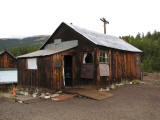Our family has always been very traditional with our Christmas dinners. There were plenty of beautiful brown turkeys, with moist stuffing (my favorite was my mother's oyster stuffing), heaps of mashed potatoes and plenty of rich gravy to go around and endless specialty side dishes . Then there were the deserts, pies, cakes, cookies and fudge. Sometimes the varieties changed but everything was always wonderful especially after smelling it cook all day and waiting for company to arrive. But for every perfect dish, there are many stories of the less than successful attempts at creating them. Somehow, those mishaps seem to be the stories that get repeated over and over until they become family traditions in themselves.
I'm sure that almost everyone that reads this story could contribute many of these same types of "
recipe's gone wrong". Here goes.
Mashed potatoes, runny or dry,
runny or lumpy, too much butter or
forgotten all together. Ever cooked too many or too few?
Waaaaaay more potatoes than gravy? How about not enough to go around? Burned on the bottom or raw and crunchy?
Gravy, thicker than the potatoes? How about greasy on the top? My favorite....just keep adding water and pepper there will be enough...... Then there is the "oh my goodness, we forgot to make the gravy!"
Turkey, too brown, too dry, not done, over done, bag of giblets baked inside on numerous occasions? Our family favorite was the junior small tom turkey...it fueled a competition between my brothers to see which one could
successfully make a small turkey feed a lot of people. Between one adding stuffing and the other "infusing" it with the baster the turkey got very large just before it E X P L O D E D.
There were rock hard rolls and
dough balls, too much baking soda or not enough and of course "uh oh...did we forget the rolls"?
Finally pies, broken crusts, burnt edges, all crust hardly any pie, all pie no crust, no
sugar, too much sugar, too runny and those that were raw. Store bought crust, first time crusts, perfect crusts with awful pie and sour pies with beautiful crusts.
No matter what kind of disaster
occurred before or
during dinner, it always seemed like the meal was perfect and the best ever! We always knew that no matter how it turned out it was full of love and we were all together, that was what made it special.
 It went something like this:
It went something like this: ME: Please?????
ME: Please?????





















